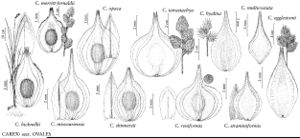Carex tetrastachya
Linnaea 22: 347. 1849.
Plants densely to loosely cespitose; rhizomes black, short to ± elongate in old clumps. Culms 30–100 cm; vegetative culms few, inconspicuous, usually fewer than 12 leaves, not strikingly 3-ranked. Leaves: sheath summits with adaxial hyaline band, truncate to rounded, sometimes prolonged beyond collar; distal ligules to 5 mm; blades 3–5 per fertile culm, 13–40 cm × 2.5–5 mm. Inflorescences densely to usually open, at least proximally, silvery white, 2.5–6 cm × 10–25 mm; proximal internode (4–)8–11 mm; 2d internode 4–8 mm; proximal bracts bristlelike to 5 cm. Spikes 2–4(–5), distant, distinct, ovoid to globose-ovoid, 11–18 × 8–13 mm, base attenuate on terminal spike, rounded on lateral spikes, apex rounded. Pistillate scales white-hyaline with light brown 1–3-veined midstripe, lanceolate to ovate, 4–6 mm, as long as and narrower than perignyia. apex acuminate with subulate tip or awnlike, awn of at least proximate staminate scales and sometimes proximal pistillate scales 0.1–0.9(–2.4) mm, scabrous. Perigynia 15–80 in larger spikes, ascending, white with light green margins, veinless over achene on each face, orbiculate or little wider than long, flat, 5.5–8(–8.7) × 3.5–6.3 mm, 0.4–0.5 mm thick, margin flat, including wing 1–2 mm wide, smooth; beak pale brown to reddish at tip, flat, (1.4–)1.6–2.5(–3.4) mm, ciliate-serrulate, abaxial suture inconspicuous or brown, distance from beak tip to achene 2.5–4 mm. Achenes oblong-elliptic, 2.5–3 × 1.5–2 mm, 0.4–0.5 mm thick. n = 30+III. 2n = 64, 66.
Phenology: Fruiting spring.
Habitat: Mesic to moist prairies, roadside ditches, shores
Elevation: 0–300 m
Distribution

La., Okla., Tex.
Discussion
Selected References
None.
